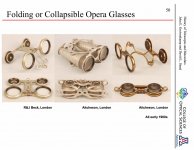A Focus Distance Scale? *
Not to make too much of this, but in most circumstances I find that the use of a focuser scale maximises the ability to raise a binocular to the eyes,
and achieve a sharp focus with minimal focuser movement.
And the longer the total focuser travel (e.g. the closer the minimum focus, and the further the over-travel at the far end), the more beneficial a focuser scale is.
After a while, checking/ pre-setting the focus when initially picking up a binocular becomes routine (just like a quick glance at the IPD setting scale).
So when you need to focus quickly you're in the best position to do so; and when speed's not needed you've reinforced a useful habit.
On the Habichts, there's both:
• a focus scale on the focuser, and;
• an index mark on the underside of the focuser arm assembly at the 6 o’clock position.
Traditionally when the zero point of the scale was set to the index mark, the focuser was at the nominal infinity focus position.
With the current models, for me infinity focus is normally achieved with the zero point at around 5 o’clock.
And my preference, depending on the anticipated circumstances is usually either . . .
a) Pre-setting the zero point to 3 o’clock, so that the focus is at around 10 metres/ 11 yards or so, and where:
• less than 1/4 turn clockwise will take the focus to infinity;
• and 1/4 turn anti-clockwise will take the focus to near the minimum distance.
b) Pre-setting the zero point to 4 o’clock, so that the focus is at around 20 metres/ 22 yards:
• with the clockwise and anti-clockwise rotation varying accordingly.
So a convenience feature for some, and an example of 'bino-craft' from an earlier time.
John
* perhaps more accurately: A Focuser Setting Scale?
Habicht 8x30 focuser scale, from left to right:
Earlier version; Current version; Indexed to nominal infinity.
View attachment 1463845


www.birdforum.net










